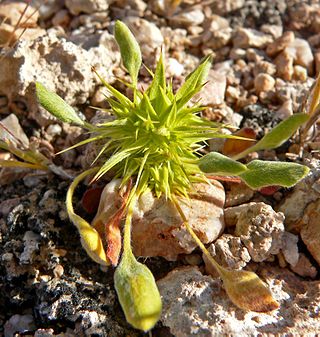
Chorizanthe is a genus of plants in the buckwheat family known generally as spineflowers. These are small, squat, herbaceous plants with spiny-looking inflorescences of flowers. The flowers may be in shades of red or yellow to white. The bracts are pointed and sometimes tipped with a hooked awn, and the inflorescence often dries into a rounded, spiny husk. Spineflowers are found in western North America and South America.

Lupinus excubitus is a species of lupine known as the grape soda lupine. Its common name refers to its sweet scent, which is said to be very reminiscent of grape soda. This species and its variants are found in Southwestern United States, especially in California and Nevada, e.g., Death Valley and Joshua Tree National Parks, and northwestern Mexico.
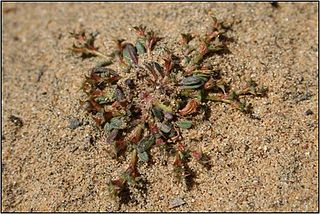
Chorizanthe orcuttiana is a rare small annual plant in the buckwheat family, Polygonaceae. It is known commonly as Orcutt's spineflower or the San Diego spineflower, and it is endemic to San Diego County, California. The plant is diminutive, and a hand-lens is necessary for proper identification. The plant is very sensitive to temperature and precipitation, and under drought or hot conditions the seeds will not germinate or survive. The plant is visible anywhere from February through July during good rain year, but most years the plant is only visible from April to June. Each minute flower yields one seed.

Chorizanthe fimbriata, the fringed spineflower, is an annual plant in the family Polygonaceae, the buckwheats. It is a member of the genus Chorizanthe, the spineflowers, and is native to southern California and northern Baja California.

Sambucus racemosa is a species of elderberry known by the common names red elderberry and red-berried elder.

Chorizanthe parryi is a species of flowering plant in the buckwheat family known by the common name Parry's spineflower and San Bernardino spineflower.
Chorizanthe biloba is a species of flowering plant in the buckwheat family known by the common name twolobe spineflower. It is endemic to California, where it is known only from the Central Coast Ranges. There are two varieties, both of which are uncommon to rare.
Chorizanthe breweri is a rare species of flowering plant in the buckwheat family known by the common names San Luis Obispo spineflower and Brewer's spineflower. It is endemic to California, where it is known from about twenty occurrences in the Central Coast Ranges of San Luis Obispo and far southern Monterey Counties. It grows in the chaparral and woodlands of the range, generally on serpentine soils. This small plant produces decumbent stems extending along the ground and sometimes growing upright to a maximum length of about half a meter. The herbage is mostly reddish in color and somewhat hairy. The inflorescence is a cluster of flowers, each surrounded by six hairy reddish bracts with hooked tips. The flower itself is only about 3 millimeters wide and is white to red and hairy.

Chorizanthe cuspidata is a species of flowering plant in the buckwheat family known by the common name San Francisco spineflower. It is endemic to California, where it is known only from the San Francisco Bay Area and to the immediate north and south. It grows in sandy coastal habitat.

Chorizanthe douglasii is a species of flowering plant in the buckwheat family known by the common names San Benito spineflower and Douglas' spineflower. It is endemic to California, where it grows in the mountains of the Southern California Coast Ranges, from the Santa Lucia Range east to the Gabilan Range.
Chorizanthe howellii is a species of flowering plant in the buckwheat family known by the common names Mendocino spineflower and Howell's spineflower. It is endemic to coastal Mendocino County, California, where it is known only from the sand dunes and coastal scrub near Fort Bragg. It is estimated that 95% of the remaining individuals of this plant are part of a single population growing at MacKerricher State Park. It is a federally listed endangered species.
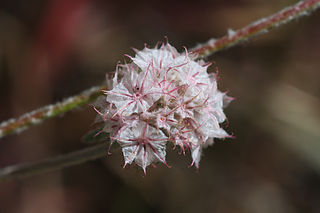
Chorizanthe membranacea is a species of flowering plant in the buckwheat family known by the common name pink spineflower. It is native to Oregon and California, where it is widespread and in some areas quite common. It can be found in a wide variety of habitats.

Chorizanthe pungens is a species of flowering plant in the buckwheat family known by the common name Monterey spineflower. It is endemic to California, where it is known from the San Francisco Bay Area south along the Central Coast.
Chorizanthe rectispina is a species of flowering plant in the buckwheat family known by the common names prickly spineflower and straight-awned spineflower. It is endemic to California, where it is known from about twenty occurrences from Monterey to Santa Barbara Counties. It grows in dry habitat types such as chaparral and woodland in the hills of the Central Coast Ranges. It is a low, spreading plant with stems up to about 25 centimeters long, grayish to greenish in color and hairy in texture. The inflorescence is a cluster of flowers, each flower surrounded by six hairy bracts which are grayish to pink in color and tipped with awns. One bract is longer than the others and has a straight awn, and the other smaller bracts may have hooked awns. The tiny flower at the center of the bract array is a few millimeters wide and white and yellow in color.

Chorizanthe robusta is a species of flowering plant in the buckwheat family. It is endemic to California, where it is a rare, federally listed endangered species.

Chorizanthe uniaristata is a species of flowering plant in the family Polygonaceae known by the common name one-awn spineflower. It is endemic to central California, where it is known from several of the local mountain ranges, as well as the Central Coast.
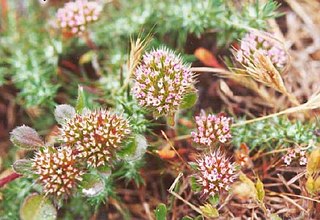
Chorizanthe valida is a rare species of flowering plant in the buckwheat family known by the common name Sonoma spineflower. It is endemic to West Marin, Marin County, California, where it is known from only one remaining natural population at Point Reyes National Seashore. It was thought to be extinct until 1980 when the Point Reyes population was discovered.
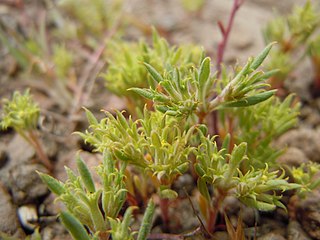
Chorizanthe watsonii is a species of flowering plant in the buckwheat family known by the common name Fivetooth Spineflower or Watson's Spineflower. They are an annual herb native to the western United States including Idaho, California, Oregon, Nevada, Utah, Washington and Arizona, namely the Mojave Desert which runs through many of them.

Chorizanthe xanti is a species of flowering plant in the buckwheat family known by the common name Riverside spineflower. It is endemic to California, where it grows in several of the mountain ranges from the Sierra Nevada to the Southern California Transverse Ranges in forest, woodland, and scrub habitats.

Chrysothamnus viscidiflorus is an American species of shrub in the family Asteraceae known by the common names yellow rabbitbrush and green rabbitbrush.
















